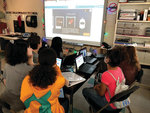

Johnston High School computer science students brought their teaching caps to Ferri Middle School on Dec. 12 as part of Rhode Island’s Hour of Code week.
JHS computer science teacher Gary Swider’s class has been coming to Ferri for the past three years as a way to inspire Ferri students and “get them all pumped” for the burgeoning area of study. Hour of Code, according to the Code.org website, started as an hour-long instructional course but evolved into a nationwide initiative.
Swider said it is vital for students to receive some exposure to computer science, and having someone closer to their age explaining it to them can make the learning process more powerful and easier to absorb.
“It’s so insanely important,” Swider said. “Just seeing the kids now respond so positively because they have the students that are just two years older than them, having them instruct is just a more internal motivation of having their sister or having somebody they know or they’ve seen before coming back and saying, ‘Computer science is so much fun, this is what you should be doing.’”
Swider said about 130 Ferri students were involved in the morning’s events, and programming included machine learning, drag-and-drop coding and “unplugged” problem-solving exercises that got their eyes off the screens. The last category, Swider said, included a process wherein students must develop a seating chart with certain constraints.
“How can they create a seating chart that works? So they go by the problem-solving process, which is preparing and defining the problem and figuring out what success looks like, which they can apply to any course,” Swider said. “They’re doing that together as well and saying, ‘OK, well Aysha and Damien have to be split up, but Aysha and Ben must be together.’ So they’re step-by-step figuring out, ‘How should I place it this way?’”
One particular coding exercise included teaching robots – tasked with cleaning the ocean – the difference between fish and trash. Students would have to program the artificial intelligence to recognize that a Solo cup isn’t a fish, for example, while being careful to address their inherent bias.
“The programmer knows theirdefinition of what a happy fish might be, but my happy fish is probably different than her happy fish and his happy fish,” Swider said. “So it’s a way of really introducing the fact of, be careful of the way you think because that is a dangerous power to have. If you’re saying, ‘This is a fish, this is a fish, this is a fish,’ and you forget a kind of fish, and you don’t program that and it’s let out in the ocean, that’s going to be killing all those fish, too.”
Johnston Public Schools instructional technology coordinator Deb Ramm said these types of projects – as opposed to those with construction paper and crayons or colored pencils – allow students an easier path to making revisions “because it’s not stuck permanently there.”
Rather than kids receiving a flat score, they can reenter the program and sculpt it in a way they see fit.
“So we can have three, four or five students working on a project collaboratively, sharing their input, changing things, tweaking things, versus once it’s glued on that piece of paper, it’s done and you can’t change that,” Ramm said. “And so now, we’re using more of that applied learning. We’re talking about communication and collaboration and critical thinking versus just creating a project for a grade and moving on.”
The joy for computer science is bred into Johnston students from a young age, starting with Scratch block coding programming in fifth-grade classrooms. Ramm said the early exposure to Scratch allows kids to be pushed to a higher level once they enter a technical education course.
“Instead of doing a poster board for a course and doing a project and creating it on a poster board – in the same way that we would’ve done it years ago – these kids are able to Scratch and code their projects, which is pretty awesome,” Ramm said. “It’s just a really nice way for them to have another outlet of creation. When they’re creating, they’re pushing their minds faster and harder and in a different direction.”
Swider knows this, too, as it emphasizes a familiar refrain that his students hear often: There’s so many ways to solve the problem, so find your way.
“In computer science, there’s an infinite number of ways to solve the same problem,” Swider said. “You can right click, you can do edit and copy, you can do control-C. There’s so many ways for solving the same problem, and that’s where each individual person kind of factors in. It’s really cool.”
Comments
No comments on this item Please log in to comment by clicking here